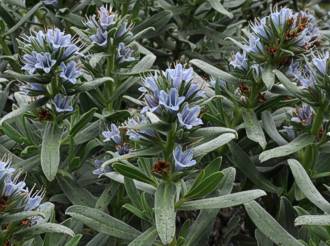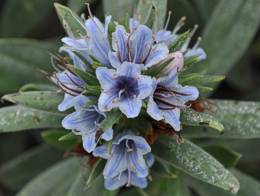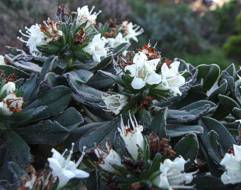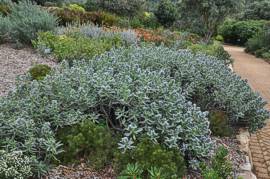Lobostemon montanus
Lobostemon montanus H. Buek
Family: Boraginaceae
Common names: mountain lobostemon (Eng.); agtdaegeneesbos (Afr.)
Introduction
Lobostemon montanus is a shrub from the Borage family with unusually large leaves for the genus, which are complemented by a cluster of pale blue flowers set within a rosette of silvery, grey-green leaves.

Description
Description
Lobostemon montanus is a woody, perennial, freely branching shrub 1 m tall and spreading up to 2 m wide. It has oval to elongated, thick, leathery, grey-green to silvery, hairy leaves forming rosette-like clusters at the ends of branches. The leaves cover the entire plant to ground level producing a compact, rounded mushroom-like effect.
The flowers are short, tubular, bell- or funnel-shaped and pale sky-blue to turquoise and face upwards. They are often striped white and blue like an old man's pajamas. There are 5 stamens per flower that often protrude from the flower; they are usually purple, providing a striking contrast with the pale flowers.

Lobostemon montanus is not as spectacular as Lobostemon belliformis, but is distinctive in that it provides hikers with a pleasant surprise when cresting an exposed mountain or when fighting their way through thick coastal scrub. It may be found nestled amongst boulders and other woody plants on a dry hill top or buttress or tucked away amongst other hardy species on a wind-blown slope. For most of the year it will not attract much attention, but from July to September it displays the most delicate blue flowers among clusters of silvery leaves.
Conservation Status
Status
Lobostemon montanus is fairly common on mountains, rocky outcrops and along the coast and is therefore classified as Least Concern in the Red Data book (Raimondo et al. 2009).
Distribution and habitat
Distribution description
There are twenty-eight species of Lobostemon endemic to South Africa, most of which are confined to the winter rainfall area from Springbok to Mossel Bay. Lobostemon montanus has a very limited distribution, being confined to the southwestern Western Cape from the Cape Peninsula to Onrust.

Derivation of name and historical aspects
History
The genus name is derived from Latin lobos, meaning lobe, and the Greek word stemon, meaning stamen. J.G.C. Lehmann established the genus in 1830 to separate it from the closely related European genus Echium. In the Boraginaceae or forget-me-not family, Lobostemon montanus is related to the well-known European herbs, comfrey (Symphytum officinale) and borage (Borago officinalis), Myosotis, Anchusa and Cynoglossum.

The specific name 'montanus' means pertaining to mountains and refers to the common occurrence of the species in mountainous areas.
Ecology
Ecology
Lobostemon montanus grows in harsh, windy, warm and dry habitats near the coast, surviving summer drought and persistent, strong summer wind. It appears to prefer rocky areas where the soils are sandy, well-drained and limited in depth. It also grows quite high on the mountains where I have seen it growing along forest margins above Kalk Bay or amongst rocks and boulders on top of peaks such as Constantiaberg or on drier west-facing buttresses such as the Twelve Apostles of Table Mountain. Its thick hairy leaves help protect it from the damaging salt-laden wind from the sea. They may resprout from the lower stems or trunk after fire if not too badly burnt, but usually recolonize from seed. They reseed themselves, most prolifically after a fire. The blue flowers attract bees and also birds, particularly the Orangebreasted and Lesser Doublecollared Sunbirds (Nectarinia violacea and N. chalybea) as well as the Cape Sugarbird (Promerops cafer).
Uses
Use
Lobostemon montanus is closely related to Lobostemon fruticosus which was used by the Khoi, the early settlers and Malays. A tea made from the leaves, if drunk first thing in the morning, was said to be a sure cure for ringworm in humans and animals - hence the Afrikaans common name, douwurmbos. The name agtdaegeneesbossie, meaning eight-day-healing-bush, refers to the belief that this plant could heal all sorts of ailments within eight days.Fresh leaves of Lobostemon fruticosus and other Lobostemon species are crushed and fried in oil or fat to make ointments to heal wounds, sores, ulcers and ringworm.

Growing Lobostemon montanus
Grow
Lobostemon montanus is relatively easy to grow in most gardens provided it is placed in a sunny position and in well-drained soils. It is particularly happy when grown in rockeries and on embankments and is a very good plant for coastal gardens because it is tolerant of salt-laden wind.
It is not cold-tolerant and will need protection from frost. In the Cape the best time to plant is during the rainy months of winter to allow plants to establish themselves before the warm, dry summers. It has performed very well at Kirstenbosch in the Erica and Protea sections. It will benefit from some top dressing around the plant with compost once a year.
Cuttings from the tips of branches or heel cuttings taken by removing a thin side shoot, root quite well providing that they are not kept too wet. Cuttings should be taken in either spring or autumn. Cuttings rooted in 50:50 milled bark and polystyrene on bottom heat with misting work best. Lobostemon montanus is a woody plant with thick leathery leaves which are drought resistant and do not wilt easily. Cuttings can therefore be made and placed in well-drained sandy soil in a garden bed on the cool south side of the house and should root after about two or three months. Occasionally spray with water if the cuttings look stressed.
Plants grow from fresh seeds collected when the old flower heads turn brownish-grey. Treat seed with hot water and thereafter with smoke to aid germination. Sow seeds in late summer or spring for best results.
References
- Goldblatt, P. & Manning, J. 2000. Cape Plants. A conspectus of the Cape flora of South Africa. Strelitzia 9. National Botanical Institute, Pretoria.
- Roberts, M. 1990. Indigenous healing plants. Southern Book Publishers, Pretoria.
- Raimondo, D., Von Staden, L., Foden, W., Victor, J.E., Helme, N.A., Turner, R.C., Kamundi, D.A. & Manyama, P.A. (eds) 2009. Red List of South African plants 2009. Strelitzia 25.South African National Biodiversity Institute, Pretoria.
- Stearn, W. T. 1992. Stearn's dictionary of plant names for gardeners. A handbook on the origin and meaning of the botanical names of some cultivated plants. Cassell, London.
- Van Wyk, B.-E. & Gericke, N. 2000. People's plants. A guide to useful plants of southern Africa. Briza Publications, Pretoria.
Credits
Kirstenbosch National Botanical Garden
Anthony Hitchcock
August 2011
Plant Attributes:
Plant Type: Shrub
SA Distribution: Western Cape
Soil type: Sandy
Flowering season: Spring, Winter
PH: Acid
Flower colour: Blue
Aspect: Full Sun
Gardening skill: Easy
Special Features:
Horticultural zones







Rate this article
Article well written and informative
Rate this plant
Is this an interesting plant?
Login to add your Comment
Back to topNot registered yet? Click here to register.